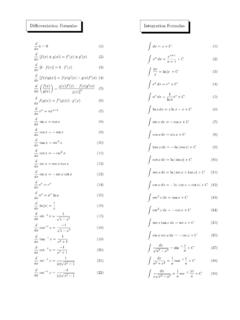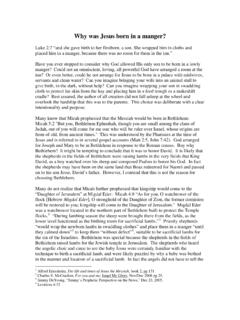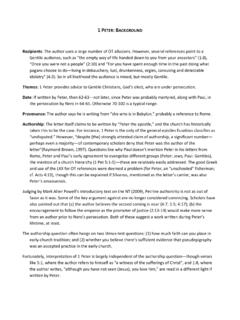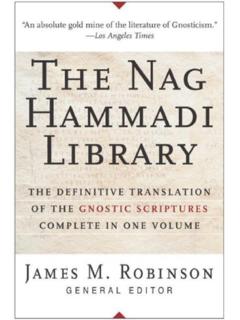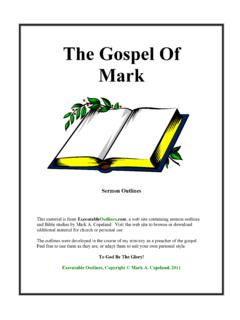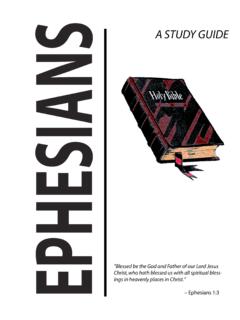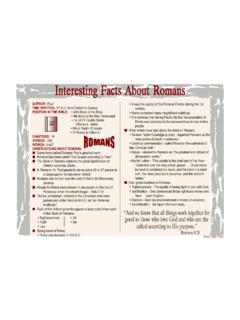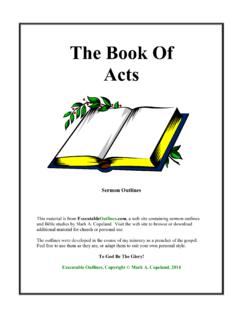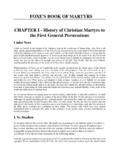Transcription of The Gospel According to Luke: Background
1 The Gospel According to Luke: BackgroundGeneral features Luke is the only Gospel with a sequel, and the only Gospel which takes us from Jesus' birth to resurrection Luke is the longest Gospel . Luke and Acts constitutes 24% of the NT Luke is the only Gospel with a sequel Luke and Acts are joined by their prologues, style, language, theology and even some parallel structure: Both open with a descent of the Holy Spirit, go on to narrate miracles and preaching, emphasize traveling, and feature trial scenes toward their close. In Luke the movement is toward Jerusalem throughout, and in Acts it's outward into the world. Note though that they are different genres: gospels are closest to Hellenistic biography, which Acts certain is not Luke draws on what appears to be an early or incomplete version of Mark, adding about the same amount more material, both from Q and from other sources ( L )Authorship There is little dispute, based on the we sections of Acts, that the author is Luke, the beloved physician (Col 4:14).
2 The author is educated Luke-Acts has the more elegant Greek of the NT, and the author shows the ability to fluidly change styles, from the classical Greek prologue to the Septuagintal Greek of the infancy narratives to the Hellenistic Greek of the rest of Luke. The author, while not Jewish, was quite possibly a God fearer before converting to ChristianityDate After Mark, which Luke uses, but also likely before Paul's death or the destruction of the temple or Nero's persecution (Rome is seen in a somewhat positive light). Opinions differ between a date in the 60s or one in the 75-85 rangeAudience Ostensibly written to Theophilus which, meaning lover of God, could be a generic address, or could be a patron and recent convert (1:4) Internal choices about the Background Lk presents, including the concern to situate the Gospel in the context of secular history, suggest a primarily (though likely mixed) Gentile audience It is likely an urban audience given the predominantly urban settingsSome Major Themes Often singled out as the key thematic verse in the Gospel of Lk is 19:10, Jesus' closing comment on the Zacchaeus episode: For the Son of Man came to seek and save what was lost.
3 Ministry to the excluded or disadvantaged, including especially Women : There is an abundance of pairs of passages where a man and a woman do the same or similar things, such as the man from Syria and the woman of Sidon (4:27; 4:25-26); the list of male followers in 6:12-16 and of female followers in 8:1-3; the demon in the man rebuked (4:31-17) and the fever in the woman rebuked (4:38); a man loses a sheep (15:4-7) and a woman loses a coin (15:8-10); etc. The poor (including those lacking honor or prestige or power, such as Samaritans or tax collectors): In Jesus' inaugural address he specifically says the purpose of his ministry is to bring good news to the poor and to let the oppressed go free (4:18; cf. 7:22) Gentiles : The Gospel is a message of hope for all people Food: Luke mentions 19 meals, 13 of which are unique to his Gospel , and Jesus is criticized for eating too much and with the wrong people Worship and Prayer: Luke opens and closes with scenes of people worshiping God in the temple, and there are 20 references in Luke to people worshiping or giving thanks, far more than in the other gospels Salvation here and now: Over and over salvation is something which is happening first now, and not just waited for at the end times.
4 So, , when Jesus says to Zacchaeus that salvation has come to his house, he means not just that his sins are forgiven, but that he's freed from slavery to mammon.

